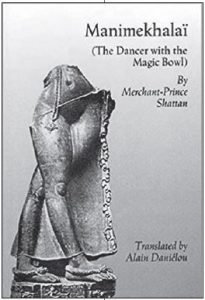 If one were to play the game of picking ‘the odd one out’ of these four books from another age—very different ages actually, elegantly produced by Aleph as part of its Classics series, each of them could prove to be the exception in one way or another. Manimekhalai, a fifth-sixth century work from the Tamil land, produced in a courtly context, is considered a Tamil epic, while the sixteenth century Telugu Prabhavati Pradyumnamu of which The Demon’s Daughter is a translation, is the only poem; The Bride’s Mirror, written in Urdu in nineteenth century Delhi would, alone of these four, be considered a novel, a literary form that in any case traces its beginnings to the late eighteenth century. The clear winner in this game of exceptions is, however, The Principles of Sufism. An Arabic work of the sixteenth century, this philosophical and spiritual meditation does not, unlike the other three, have a ‘plot’ or ‘story line’ upon which different purposes can be hung—discussion of various contemporary philosophies, Vedism, Buddhism, Jainism, Ajivikism among others, and extolling of the Buddhist path as superior in the case of Manimekhalai, a composition in honour of one’s father in the second case, and instructing young women in good conduct and efficient housekeeping—a fascinating example of didacticism, in the third. While Manimekhalai is named after its heroine, The Demon’s Daughter after both the hero and heroine of the romantic pair, Prabhavati and Pradyumna, and the third book is addressed primarily to a female audience, these three are works by men, unlike The Principles of Sufism, which despite little reference to women per se, is the composition of a woman mystic. It is also the only book of the four which employs diacritics. And of course, the fact that it comes from Damascus also sets it far apart from the rest; in fact, it is interesting that it is included in this Aleph series, which is apparently dedicated to preserving the Indian subcontinent’s literary heritage.
If one were to play the game of picking ‘the odd one out’ of these four books from another age—very different ages actually, elegantly produced by Aleph as part of its Classics series, each of them could prove to be the exception in one way or another. Manimekhalai, a fifth-sixth century work from the Tamil land, produced in a courtly context, is considered a Tamil epic, while the sixteenth century Telugu Prabhavati Pradyumnamu of which The Demon’s Daughter is a translation, is the only poem; The Bride’s Mirror, written in Urdu in nineteenth century Delhi would, alone of these four, be considered a novel, a literary form that in any case traces its beginnings to the late eighteenth century. The clear winner in this game of exceptions is, however, The Principles of Sufism. An Arabic work of the sixteenth century, this philosophical and spiritual meditation does not, unlike the other three, have a ‘plot’ or ‘story line’ upon which different purposes can be hung—discussion of various contemporary philosophies, Vedism, Buddhism, Jainism, Ajivikism among others, and extolling of the Buddhist path as superior in the case of Manimekhalai, a composition in honour of one’s father in the second case, and instructing young women in good conduct and efficient housekeeping—a fascinating example of didacticism, in the third. While Manimekhalai is named after its heroine, The Demon’s Daughter after both the hero and heroine of the romantic pair, Prabhavati and Pradyumna, and the third book is addressed primarily to a female audience, these three are works by men, unlike The Principles of Sufism, which despite little reference to women per se, is the composition of a woman mystic. It is also the only book of the four which employs diacritics. And of course, the fact that it comes from Damascus also sets it far apart from the rest; in fact, it is interesting that it is included in this Aleph series, which is apparently dedicated to preserving the Indian subcontinent’s literary heritage.
The choice of Manimekhalai for this series is also slightly puzzling because it is simply a reprint of Alain Danielou’s thirty-odd years’ old translation which till very recently continued to be available in Penguin Classics. The plot of the epic itself is convoluted beyond belief or comprehension—the Mahabharata which has more subplots and parallel stories than any other text on earth is probably less knotty and less given to improbable magic. At the risk of appearing a total philistine without sufficient appreciation for classical literature, I must confess that the plot of Manimekhalai appears just short of bizarre to me.

